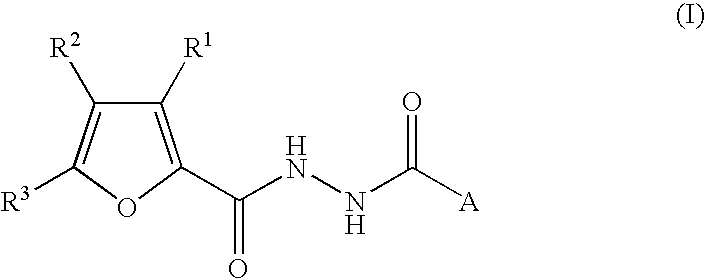2-Furancarboxylic acid hydrazides and pharmaceutical compositions containing the same
a technology of furancarboxylic acid and compound, which is applied in the field of new drugs, can solve the problems of glucagon receptor antagonists, peptidergic glucagon receptor antagonists are susceptible to enzymolysis and do not have activities, and none of them are used clinically, and achieves the effect of potent antagonistic activity
- Summary
- Abstract
- Description
- Claims
- Application Information
AI Technical Summary
Benefits of technology
Problems solved by technology
Method used
Image
Examples
experiment 2
Inhibitory Effect on the Blood Sugar Increase Caused by Glucagon Stimulation in Rats
[0245] This experiment was carried out according to the method described in J. Med. Chem. 2001, 44 (19), 3141-3149.
[0246] 5-16 Male SD rats (body weight at the time of testing: 200-250 g) were used per group in this experiment. Each test compound was suspended in 0.5% tragacanth and orally administered into the animals in a specific amount. Glucagon (Peptide Institute Inc.) was intravenously administered 30 minutes later in a dose of 3.0 μg / kg, and 10 minutes later blood was collected from the tails of the rats. The blood thus collected was centrifuged, and the glucose concentration in the plasma was measured according to the glucose oxidase method. The test animals were purchased from Charles River Japan Inc., and were allowed to eat feed (standard forage CE-2; CLEA-Japan Inc.) and drink water at will until the test morning.
[0247] A number of compounds listed in Table 3 significantly suppressed th...
experiment 3
Blood Sugar Decreasing Action to GK (Goto-Kakizaki) Rats
[0248] Male GK rats (9-11 weeks old) having a blood sugar level of at least 160 mg / dl were used in this experiment. GK rats herein are established as type II diabetes model rats. Within 3 days of the beginning of the experiment, the rats used in this experiment were divided into groups with 9 rats per group to balance the blood sugar levels. A specific amount of a test compound suspended in 0.5% CMC was orally administered into the rats, and 4 hours later blood was collected from the tails of the rats. The blood thus collected was centrifuged, and the glucose concentration in the plasma was measured according to the glucose oxidase method. The test animals were purchased from Charles River Japan Inc., and were allowed to eat feed (standard forage CE-2; CLEA-Japan Inc.) and drink water at will until the test morning.
[0249] A number of compounds listed in Table 3 significantly decreased the blood sugar levels at a dose of 3-100 ...
reference example 1
Preparation of ethyl 3-bromo-2-furancarboxylate
[0265] WSC (17.3 g), 4-dimethylaminopyridine (1.1 g) and ethanol (5.2 ml) were added to a dichloromethane solution (100 ml) of 17.2 g 3-bromo-2-furancarboxylic acid and stirred for 5 hours at 25° C. The reaction solution was washed with saturated brine and dried over MgSO4. The solvent was evaporated under reduced pressure, and the residue was purified by silica gel column chromatography (eluent: ethyl acetate / hexane=1 / 30), thereby giving 17.5 g of the desired compound.
[0266] The starting compound, i.e., 3-bromo-2-furancarboxylic acid, was prepared according to the method described in Bull. Soc. Chim. 1970, 1838-1846 and J. Chem. Soc., Perkin Trans. II 1998, 679-689.
PUM
| Property | Measurement | Unit |
|---|---|---|
| Time | aaaaa | aaaaa |
| Time | aaaaa | aaaaa |
| Time | aaaaa | aaaaa |
Abstract
Description
Claims
Application Information
 Login to View More
Login to View More - R&D
- Intellectual Property
- Life Sciences
- Materials
- Tech Scout
- Unparalleled Data Quality
- Higher Quality Content
- 60% Fewer Hallucinations
Browse by: Latest US Patents, China's latest patents, Technical Efficacy Thesaurus, Application Domain, Technology Topic, Popular Technical Reports.
© 2025 PatSnap. All rights reserved.Legal|Privacy policy|Modern Slavery Act Transparency Statement|Sitemap|About US| Contact US: help@patsnap.com



